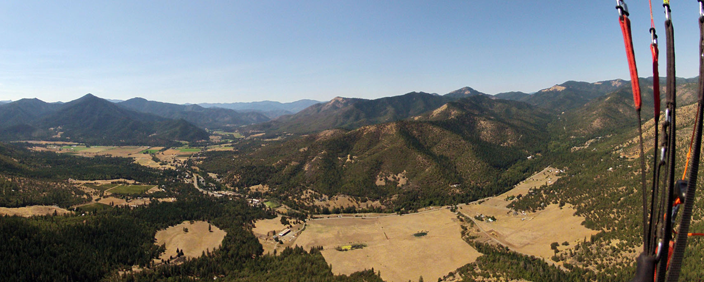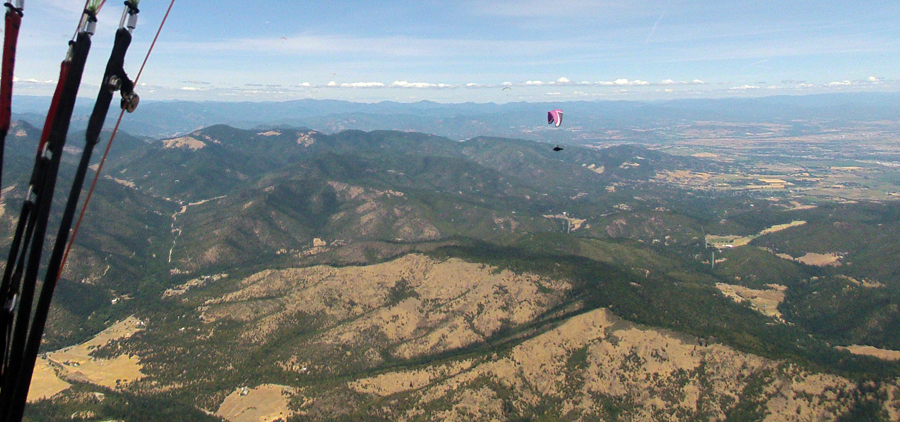An Article by Rick Ray
Once upon a time, there were three paragliding pilots named Lucky, Skilled, and Judgment. Much like the story of the three little pigs, it was the last named of the three pigs that kept them all from finally getting devoured by the Bad Wolf. In the real world, it is educated judgment that will go a long way towards insuring that you have a safe flying career.It will help you chose when, where and how to fly.
The following is a test run for a discussion about Flying at Woodrat and How and Why it seems to work as it does. Some of what follows are educated guesses on mine and others part. I hope to help our newer pilots and relocated pilots gain an understanding of why our airmass is as it is. For newer pilots to hear talk about House Thermals, Convergence Lines, Rotor Zones, and the Wall of Wind is intimidating and makes what they are getting ready to launch into mysterious and slightly spooky. Hopefully, this discussion will help you fly with more confidence and insight.
I want to introduce an awesome, free, weather resource that will professional level discussions and illustrations of what is happening around Woodrat.
https://www.meted.ucar.edu/index.php
I would strongly encourage you to create your own account. After you have created your account click on the Education and Training button and then, after browsing around, click on the Mountain Meteorology button.
From a meteorological viewpoint, Burnt Ridge is one of the more important features influencing the flying in the immediate vicinity of Woodrat.
https://www.meted.ucar.edu/training_module.php?id=57#.VKLbJl4CcA.
This module on “flow interaction with topography” found in the Mountain Meteorology section illustrates how and why Burnt plays such an important role in our local flying. As the valley flow comes by Woodrat, we can see how Burnt Ridge creates a compression zone that effectively slows the wind down in the immediate area of Woodrat Mountain. We can see how and why that the outer edge of that compression area (towards Longsword) causes a deflection of some of the incoming valley wind causing an acceleration or barrier jet to form. This is our so-called Wall of Wind. Understand when they say jet, that they are only talking about a relative escalation of the ambient wind speed. Simplistically pu, wind ,like water, seeks the path of least resistance. Instead of pushing against the gradient caused by Burnt Ridge, and rather than having to push through the existing compressed airmass or climb up and over it, some of the air takes the path of least resistance and hurries off towards the lake.
Burnt Ridge is also one of the causal factors in why we have such frequent convergence zones in the immediate vicinity of Woodrat. Air is never a static state. It pulses and surges and ebbs.This undulation is caused in part by the Applegate valley flow pressure out near Longsword. As the valley flow surges or ebbs, it causes the slowed down airmass from the vicinity of school to Burnt Ridge to flex by either tightening up or relaxing. Think just for a moment of a big crowd of people in a confined area. Add one more, they squish together. Take one away and everyone relaxes a little bit. Same thing at Woodrat. Pressure against a compression zone causes ripples to run through the compressed airmass. Another cause of convergence caused by Burnt Ridge is the downward flowing air in Forrest Creek attempting to squeeze into the compressed air in front of Burnt.
Burnt Ridge plays a very important role in the quality of our flying experience at Woodrat. Hopefully this brief look at Flow interaction With Topography will stimulate a good discussion. If we can learn and visualize what is going on, we will make safer flying decisions over time.
Rick Ray
December 30, 2014

